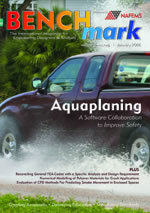BENCHmark January 2006
How do we encourage vendor collaboration?

In this Issue:
"Hosting the debate" is an important role for NAFEMS. As an independent body amongst the engineering analysis community with no vested commercial interest in any particular technical solution, we are one of the few places where everyone involved can meet on truly neutral territory. So it is no real surprise that fruitful and meaningful discussions often take place during the events that we hold. This was highly evident during a round table discussion towards the end of the 2003 NAFEMS World Congress in Orlando, when several large industrial players – such as Boeing and Airbus – who are most usually to be found locked in fierce competition with one another, joined forces to urge the different engineering analysis software vendors to significantly improve the ways in which data and models can be shared between different applications. A similar theme emerged during another productive discussion at the end of a recent seminar arranged jointly with ESA.
Of course there are many and varied business reasons which will hinder the delivery of efficient solutions for data exchange between analysis packages. "Who owns the problem?", especially given the myriad of different software products that can be purchased. Is there a real commercial driver for a vendor to develop an excellent set of tools to convert data to the format of a competitor, and would doing so heighten the risk that his customers would find it easier to swap to an alternative package? And what of the various translators that are available to translate a model from one data deck format to another – don’t these offer a viable solution? It’s clear from the NAFEMS events that I’ve witnessed that many of the thought leaders in industry don’t think so.
At the ESA seminar, one of the issues associated with this discussion was how the agenda should be set for future software developments. Of course we live in a commercial world and so the marketplace rules supreme, but how do customers of different software products unite and make certain that they give a clear message to those that want to hear what the market wants? Perhaps this is an area where NAFEMS has more work to do.
Nevertheless, it is clear from some of the articles that we see in this issue of BENCHmark, such as the development of tools to simulate aquaplaning, and the report on findings of the Multiphysics sector of FENet, that complex applications are already benefiting from better communication between CFD and FEA packages. These benefits could yet develop into the necessary business driver to provide the impetus for generating improved communication between all engineering analysis tools.
Tim Morris, Chief Executive
January 2006



